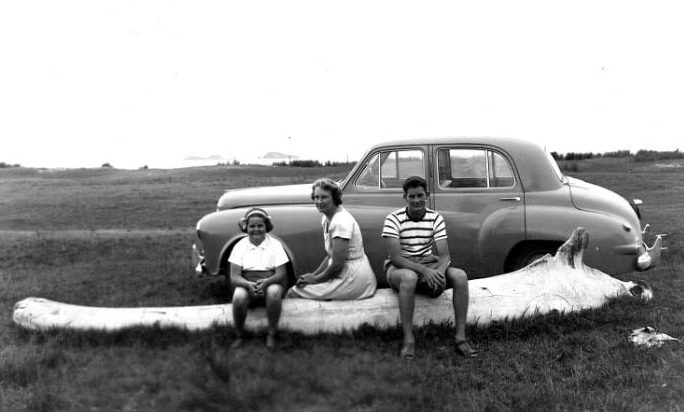
In 1951, Lora, Maree and Malcolm Morgan were among those who sat on a whale’s jawbone at Long Beach – but everything was soon to change. Photo: Eddie Morgan.
The year was 1945 and, in the worry and fear of wartime, a suspected submarine was sighted off the NSW South Coast.
“I heard the story from my late Uncle Neil, who lived in the Batemans Bay region at the time,” said Colleen Krestensen, a member of the Long Beach community.
“He always remembered a rumour circulating about an enemy submarine being bombed off the coast of Eurobodalla, and shortly after an enormous whale washed up on the beach with a gaping hole in its side.
“People realised it wasn’t a submarine at all – it was actually a whale that had been bombed.”
Some smaller whale bones were spread around the Batemans Bay area and one of the whale’s jawbones was kept on the foreshore and used as a bench until it suddenly went missing.
Ms Krestensen said it was confounding how exactly the jaw bone was removed from its place on the beach.
“How would you move a four-metre bone across the mountain?” she said.
“You’ve have to have some sort of large trailer or something to move it.”
The story (and the mystery) became part of the region’s folklore. There was a resurgence of interest in the story after social historian Alastair Greig took a look at newspaper articles from around 1945.
“We hadn’t previously found anything because we’d been searching under the term Long Beach, but he recalled that the area used to be called Higgins Beach,” Ms Krestensen said.
“He found two fascinating newspaper articles – one from Wagga Wagga and one from a Braidwood paper – that spoke of the story of the whale washing up.
“One of them affirmed that Air Force folk had come out to the beach and looked at the dead whale with the gaping, great wound on its side – he said that it was definitely bomb damage because it was probably mistaken for a submarine.”
Ms Krestensen said the articles also gave them new information, such as the size of the animal.
“One of the articles, for example, talks about how the whale attracted enormous packs of sharks at the time, because it was such a large creature,” she said.
“At high tide, enormous packs of sharks were circulating around the whale feeding and the newspaper article warned locals not to go swimming at the beach because of the sharks.”
There was a surprise, however – one article mentioned that a woman from Braidwood took one of the animal’s jaw bones as a souvenir.
“That really captured our imagination – it made us wonder if one of the missing bones was still out there in a garden somewhere in Braidwood,” Ms Krestensen said.
While some folk tales are exaggerated over the decades, Ms Krestensen wasn’t surprised that newspapers backed up the local legend.
“The story has been in the spoken history of Long Beach and Batemans Bay for some time,” she said.
“We were confident that the story that we had was accurate, but it was reaffirming to know that there was contemporary evidence.”
Now, the community of Long Beach has put the call out for information, asking anyone who knows where the whale bones ended up to come forward.
“We have been talking to our new friends in the Braidwood Historical Society to see if it can be found in a backyard in Braidwood somewhere,” she said.
“But there have been no definitive leads yet.”
Ms Krestensen said she was interested in tracing the story of the bones, both large and small.
“We are aware that it might have been sent to the tip at this stage,” she said. “But even to know where the bones were would be of interest to us.”
Original Article published by Claire Sams on About Regional.













